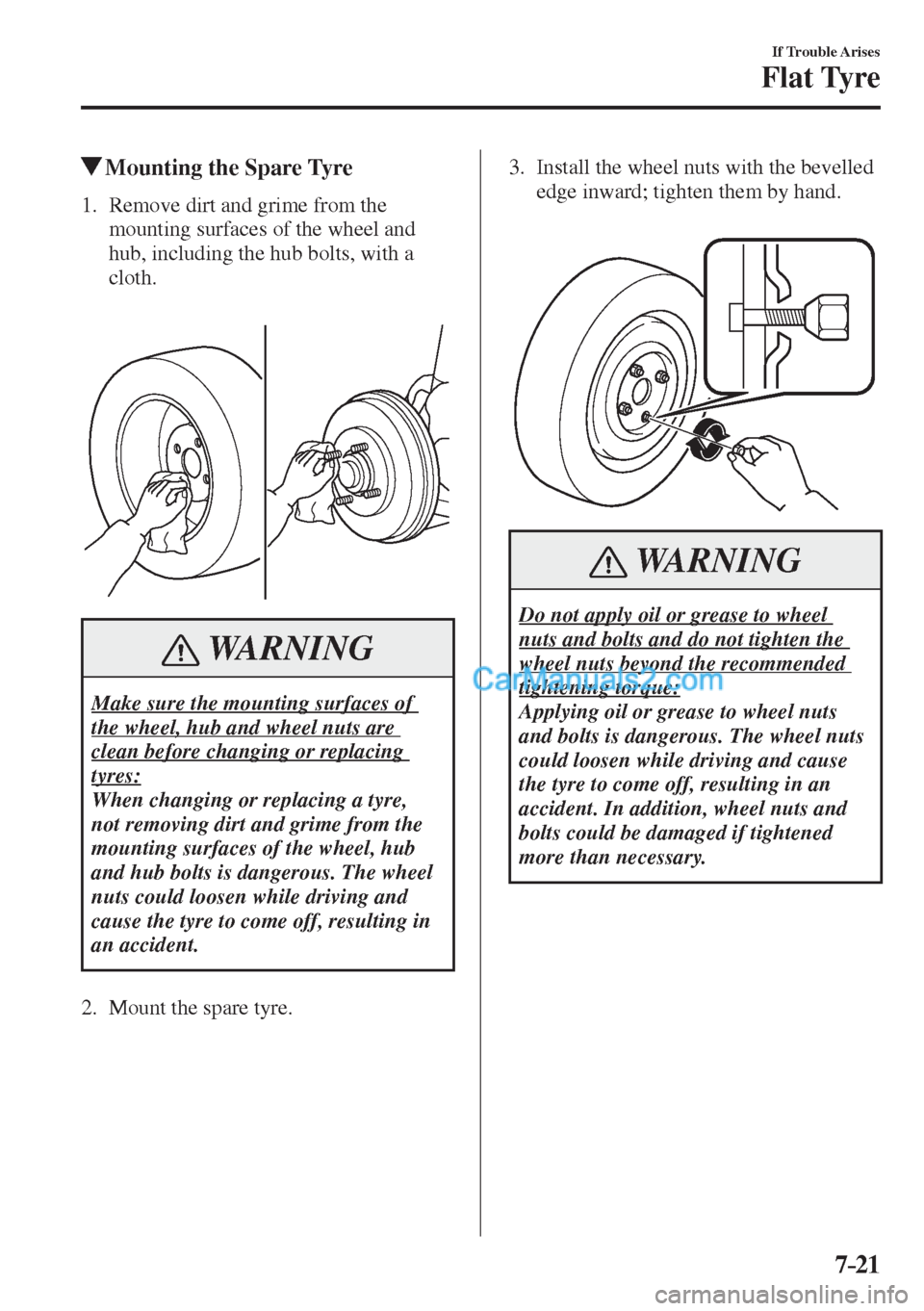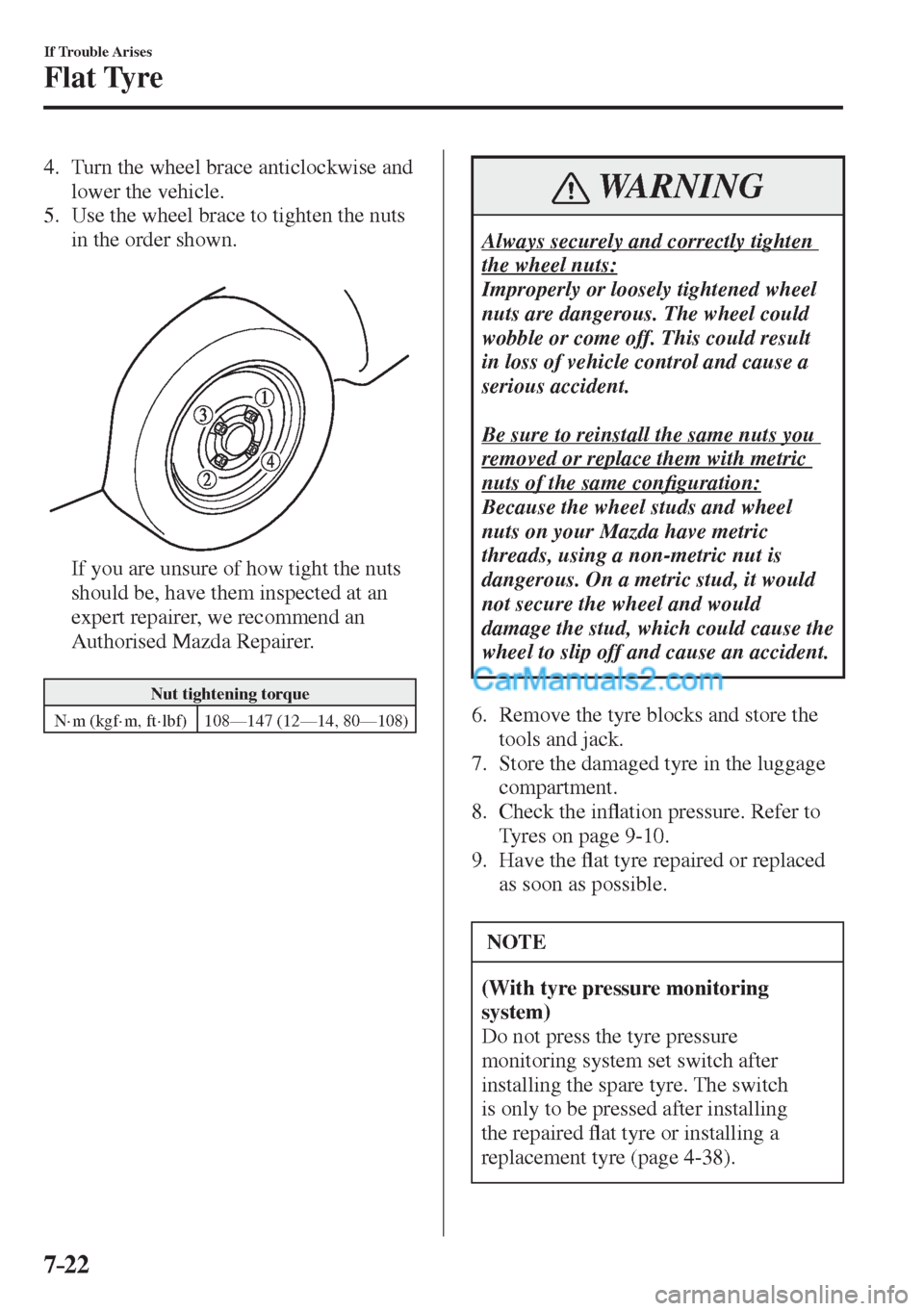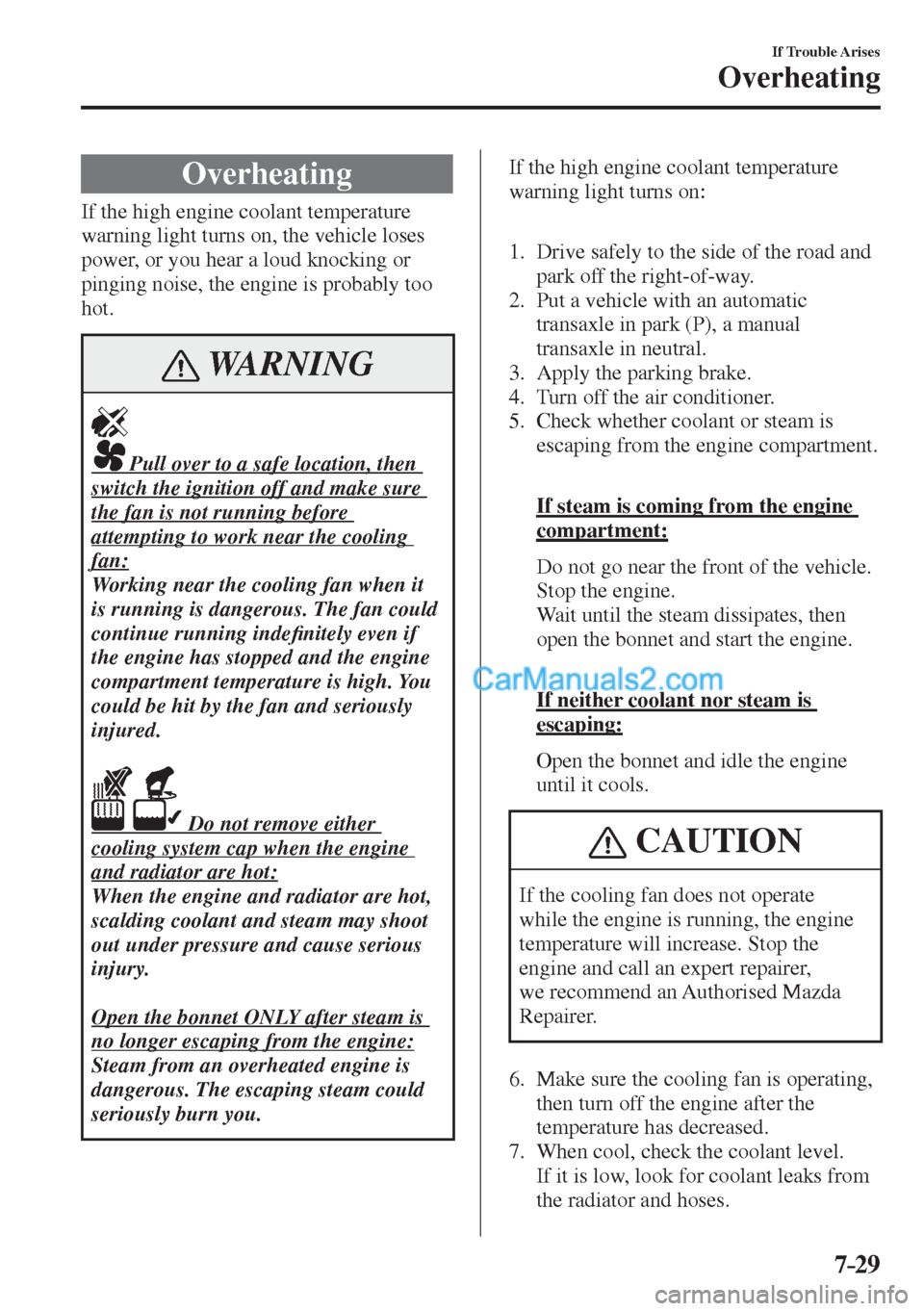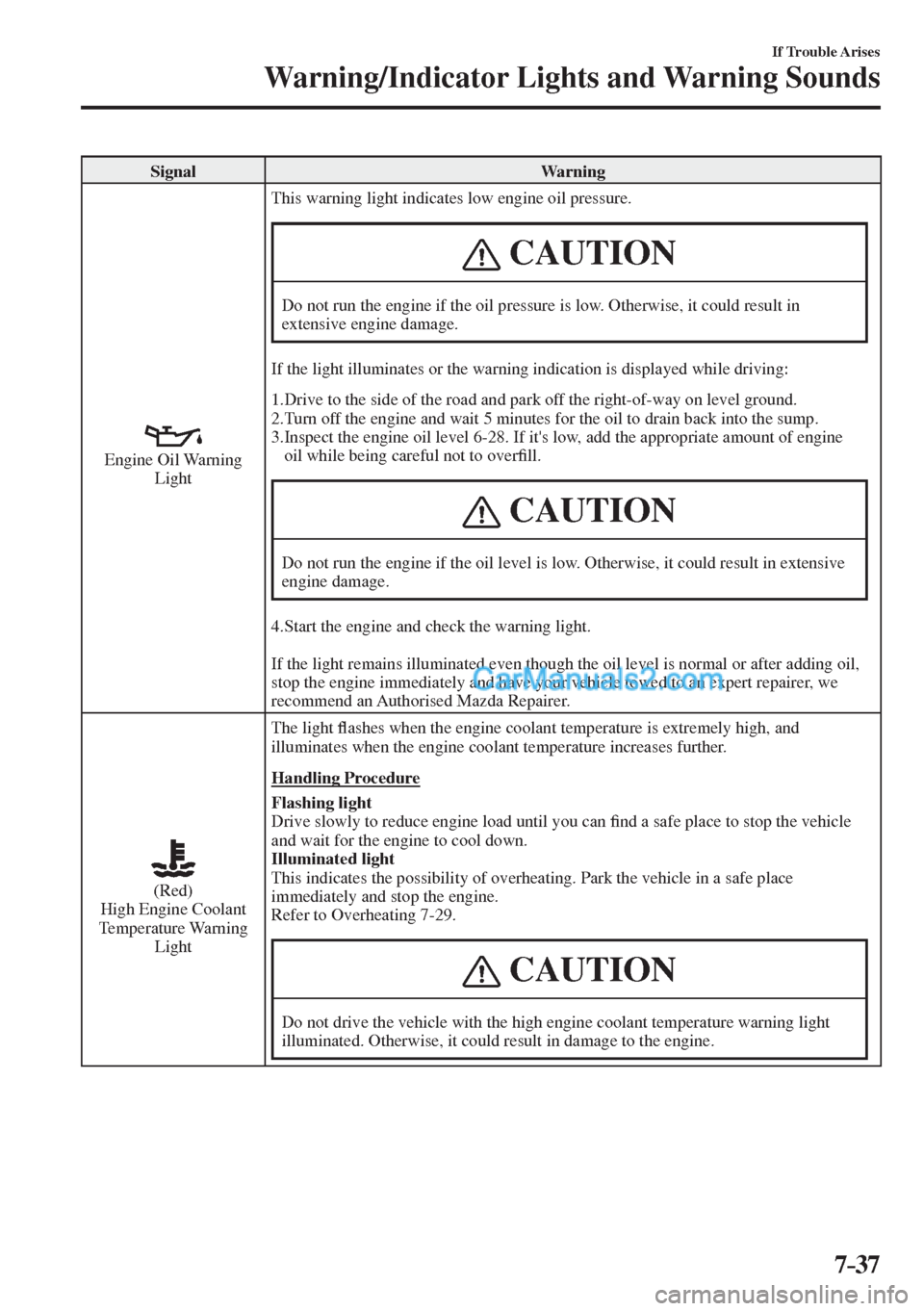warning MAZDA MODEL 2 2017 Owners Manual (in English)
[x] Cancel search | Manufacturer: MAZDA, Model Year: 2017, Model line: MODEL 2, Model: MAZDA MODEL 2 2017Pages: 711, PDF Size: 17.89 MB
Page 614 of 711

7–20
If Trouble Arises
Flat Tyre
7. Insert the jack lever and attach the
wheel brace to tyre jack.
8. Turn the jack handle clockwise and
raise the vehicle high enough so that
the spare tyre can be installed. Before
removing the wheel nuts, make sure
your Mazda is �¿ rmly in position and
that it cannot slip or move.
WARNING
Do not jack up the vehicle higher than
is necessary:
Jacking up the vehicle higher than
is necessary is dangerous as it could
destabilize the vehicle resulting in an
accident.
Do not start the engine or shake the
vehicle while it is jacked up:
Starting the engine or shaking
the vehicle while it is jacked up is
dangerous as it could cause the vehicle
to fall off the jack resulting in an
accident.
Never go under the vehicle while it is
jacked up:
Going under the vehicle while it is
jacked up is dangerous as it could
result in death or serious injury if the
vehicle were to fall off the jack.
9. Remove the wheel nuts by turning
them anticlockwise; then remove the
wheel and centre cap.
Page 615 of 711

7–21
If Trouble Arises
Flat Tyre
Mounting the Spare Tyre
1. Remove dirt and grime from the
mounting surfaces of the wheel and
hub, including the hub bolts, with a
cloth.
WARNING
Make sure the mounting surfaces of
the wheel, hub and wheel nuts are
clean before changing or replacing
tyres:
When changing or replacing a tyre,
not removing dirt and grime from the
mounting surfaces of the wheel, hub
and hub bolts is dangerous. The wheel
nuts could loosen while driving and
cause the tyre to come off, resulting in
an accident.
2. Mount the spare tyre. 3. Install the wheel nuts with the bevelled
edge inward; tighten them by hand.
WARNING
Do not apply oil or grease to wheel
nuts and bolts and do not tighten the
wheel nuts beyond the recommended
tightening torque:
Applying oil or grease to wheel nuts
and bolts is dangerous. The wheel nuts
could loosen while driving and cause
the tyre to come off, resulting in an
accident. In addition, wheel nuts and
bolts could be damaged if tightened
more than necessary.
Page 616 of 711

7–22
If Trouble Arises
Flat Tyre
4. Turn the wheel brace anticlockwise and
lower the vehicle.
5. Use the wheel brace to tighten the nuts
in the order shown.
If you are unsure of how tight the nuts
should be, have them inspected at an
expert repairer, we recommend an
Authorised Mazda Repairer.
Nut tightening torque
N·m (kgf·m, ft·lbf) 108—147 (12—14, 80—108)
WARNING
Always securely and correctly tighten
the wheel nuts:
Improperly or loosely tightened wheel
nuts are dangerous. The wheel could
wobble or come off. This could result
in loss of vehicle control and cause a
serious accident.
Be sure to reinstall the same nuts you
removed or replace them with metric
nuts of the same con�¿ guration:
Because the wheel studs and wheel
nuts on your Mazda have metric
threads, using a non-metric nut is
dangerous. On a metric stud, it would
not secure the wheel and would
damage the stud, which could cause the
wheel to slip off and cause an accident.
6. Remove the tyre blocks and store the
tools and jack.
7. Store the damaged tyre in the luggage
compartment.
8. Check the in�À ation pressure. Refer to
Tyres on page 9-10 .
9. Have the �À at tyre repaired or replaced
as soon as possible.
NOTE
(With tyre pressure monitoring
system)
Do not press the tyre pressure
monitoring system set switch after
installing the spare tyre. The switch
is only to be pressed after installing
the repaired �À at tyre or installing a
replacement tyre (page 4-38 ).
Page 617 of 711

7–23
If Trouble Arises
Flat Tyre
WARNING
Do not drive with any tyres that have
incorrect air pressure:
Driving on tyres with incorrect air
pressure is dangerous. Tyres with
incorrect pressure could affect
handling and result in an accident.
When you check the regular tyres' air
pressure, check the spare tyre, too.
NOTE
To prevent the jack and tool from
rattling, store them properly.
Page 618 of 711

7–24
If Trouble Arises
Battery Runs Out
J u m p - S t a r t i n g
Jump-starting is dangerous if done incorrectly. So follow the procedure carefully. If you
feel unsure about jump-starting, we strongly recommend that you have a competent service
technician do the work.
WARNING
Follow These Precautions Carefully:
To ensure safe and correct handling of the battery, read the following precautions
carefully before using the battery or inspecting it.
Do not allow the positive ( ) terminal to contact any other metal object that
could cause sparks:
Flames and sparks near open battery cells are dangerous. Hydrogen gas, produced
during normal battery operation, could ignite and cause the battery to explode. An
exploding battery can cause serious burns and injuries. When working near a battery,
do not allow metal tools to contact the positive (
) or negative ( ) terminal of the
battery.
Keep all �À ames, including cigarettes, and sparks away from open battery cells:
Flames and sparks near open battery cells are dangerous. Hydrogen gas, produced
during normal battery operation, could ignite and cause the battery to explode. An
exploding battery can cause serious burns and injuries.
Do not jump-start a frozen battery or one with a low �À uid level:
Jump-starting a frozen battery or one with a low �À uid level is dangerous. It may rupture
or explode, causing serious injury.
Connect the negative lead to a good ground point away from the battery:
Connecting the end of the second jumper lead to the negative (
) terminal of the
discharged battery is dangerous.
A spark could cause the gas around the battery to explode and injure someone.
Route the jumper leads away from parts that will be moving:
Connecting a jumper lead near or to moving parts (cooling fans, belts) is dangerous.
The lead could get caught when the engine starts and cause serious injury.
Page 621 of 711

7–27
If Trouble Arises
Emergency Starting
Starting a Flooded Engine
(SKYACTIV-G 1.3 and
SKYACTIV-G 1.5 )
If the engine fails to start, it may be
�À ooded (excessive fuel in the engine).
Follow this procedure:
1. If the engine does not start within
�¿ ve seconds on the �¿ rst try, wait ten
seconds and try again.
2. Make sure the parking brake is on.
3. Depress the accelerator all the way and
hold it there.
4. Depress the clutch pedal (Manual
transaxle) or the brake pedal
(Automatic transaxle), then press the
push button start. If the engine starts,
release the accelerator immediately
because the engine will suddenly rev
up.
5. If the engine fails to start, crank it
without depressing the accelerator.
If the engine still does not start using
the previous procedure, have your
vehicle inspected by an expert repairer,
we recommend an Authorised Mazda
Repairer.
Push-Starting
Do not push-start your Mazda.
WARNING
Never tow a vehicle to start it:
Towing a vehicle to start it is
dangerous. The vehicle being towed
could surge forward when its engine
starts, causing the two vehicles to
collide. The occupants could be
injured.
CAUTION
Do not push-start a vehicle that has a
manual transaxle. It can damage the
emission control system.
NOTE
You cannot start a vehicle with an
automatic transaxle by pushing it.
Page 623 of 711

7–29
If Trouble Arises
Overheating
O v e r h e a t i n g
If the high engine coolant temperature
warning light turns on, the vehicle loses
power, or you hear a loud knocking or
pinging noise, the engine is probably too
hot.
WARNING
Pull over to a safe location, then
switch the ignition off and make sure
the fan is not running before
attempting to work near the cooling
fan:
Working near the cooling fan when it
is running is dangerous. The fan could
continue running inde�¿ nitely even if
the engine has stopped and the engine
compartment temperature is high. You
could be hit by the fan and seriously
injured.
Do not remove either
cooling system cap when the engine
and radiator are hot:
When the engine and radiator are hot,
scalding coolant and steam may shoot
out under pressure and cause serious
injury.
Open the bonnet ONLY after steam is
no longer escaping from the engine:
Steam from an overheated engine is
dangerous. The escaping steam could
seriously burn you.
If the high engine coolant temperature
warning light turns on:
1. Drive safely to the side of the road and
park off the right-of-way.
2. Put a vehicle with an automatic
transaxle in park (P), a manual
transaxle in neutral.
3. Apply the parking brake.
4. Turn off the air conditioner.
5. Check whether coolant or steam is
escaping from the engine compartment.
If steam is coming from the engine
compartment:
Do not go near the front of the vehicle.
Stop the engine.
Wait until the steam dissipates, then
open the bonnet and start the engine.
If neither coolant nor steam is
escaping:
Open the bonnet and idle the engine
until it cools.
CAUTION
If the cooling fan does not operate
while the engine is running, the engine
temperature will increase. Stop the
engine and call an expert repairer,
we recommend an Authorised Mazda
Repairer.
6. Make sure the cooling fan is operating,
then turn off the engine after the
temperature has decreased.
7. When cool, check the coolant level.
If it is low, look for coolant leaks from
the radiator and hoses.
Page 629 of 711

7–35
If Trouble Arises
Warning/Indicator Lights and Warning Sounds
If a Warning Light Turns On or Flashes
If any warning light turns on/�À ashes, take appropriate action for each light. There is no
problem if the light turns off, however if the light does not turn off or turns on/�À ashes again,
consult an Authorised Mazda Repairer.
(Vehicles with type B audio)
The warning contents can be veri�¿ ed on the centre display.
1. If the warning light is turned on, select icon on the home screen to display the
application screen.
2. Select “Vehicle Status Monitor”.
3. Select “Warning Guidance” to display the current warnings.
4. Select the applicable warning to view the warning details.
Stop Vehicle in Safe Place Immediately
If any of the following warning lights turns on, the system may have a malfunction. Stop the
vehicle in a safe place immediately and contact an Authorised Mazda Repairer.
Signal Warning
Brake System Warning
Light
This warning has the following functions:
Parking brake warning/Warning light inspection
The light illuminates when the parking brake is applied with the ignition switched to
START or ON. It turns off when the parking brake is fully released.
Low brake �À uid level warning
If the brake warning light remains illuminated even though the parking brake is
released, the brake �À uid may be low or there could be a problem with the brake
system. Park the vehicle in a safe place immediately and contact an expert repairer, we
recommend an Authorised Mazda Repairer.
WARNING
Do not drive with the brake system warning light illuminated. Contact an expert
repairer, we recommend an Authorised Mazda Repairer to have the brakes
inspected as soon as possible:
Driving with the brake system warning light illuminated is dangerous. It
indicates that your brakes may not work at all or that they could completely fail
at any time. If this light remains illuminated, after checking that the parking
brake is fully released, have the brakes inspected immediately.
CAUTION
In addition, the effectiveness of the braking may diminish so you may need to
depress the brake pedal more strongly than normal to stop the vehicle.
Page 630 of 711

7–36
If Trouble Arises
Warning/Indicator Lights and Warning Sounds
Signal Warning
Electronic Brake Force
Distribution System
Warning If the electronic brake force distribution control unit determines that some components
are operating incorrectly, the control unit may illuminate the brake system warning
light and the ABS warning light simultaneously. The problem is likely to be the
electronic brake force distribution system. WARNING
Do not drive with both the ABS warning light and brake warning light
illuminated. Have the vehicle towed to an expert repairer, we recommend an
Authorised Mazda Repairer to have the brakes inspected as soon as possible:
Driving when the brake system warning light and ABS warning light are
illuminated simultaneously is dangerous.
When both lights are illuminated, the rear wheels could lock more quickly in an
emergency stop than under normal circumstances.
Charging System
Warning Light If the warning light turns on while driving, it indicates a problem with the generator or
the charging system.
Drive to the side of the road and park off the right-of-way. Consult an expert repairer,
we recommend an Authorised Mazda Repairer.
CAUTION
Do not continue driving when the charging system warning light is illuminated
because the engine could stop unexpectedly.
Page 631 of 711

7–37
If Trouble Arises
Warning/Indicator Lights and Warning Sounds
Signal Warning
Engine Oil Warning
Light This warning light indicates low engine oil pressure.
CAUTION
Do not run the engine if the oil pressure is low. Otherwise, it could result in
extensive engine damage.
If the light illuminates or the warning indication is displayed while driving:
1. Drive to the side of the road and park off the right-of-way on level ground.
2. Turn off the engine and wait 5 minutes for the oil to drain back into the sump.
3. Inspect the engine oil level 6-28 . If it's low, add the appropriate amount of engine
oil while being careful not to over�¿ ll.
CAUTION
Do not run the engine if the oil level is low. Otherwise, it could result in extensive
engine damage.
4. Start the engine and check the warning light.
If the light remains illuminated even though the oil level is normal or after adding oil,
stop the engine immediately and have your vehicle towed to an expert repairer, we
recommend an Authorised Mazda Repairer.
(Red)
High Engine Coolant
Temperature Warning
Light
The light �À ashes when the engine coolant temperature is extremely high, and
illuminates when the engine coolant temperature increases further.
Handling Procedure
Flashing light
Drive slowly to reduce engine load until you can �¿ nd a safe place to stop the vehicle
and wait for the engine to cool down.
Illuminated light
This indicates the possibility of overheating. Park the vehicle in a safe place
immediately and stop the engine.
Refer to Overheating 7-29 .
CAUTION
Do not drive the vehicle with the high engine coolant temperature warning light
illuminated. Otherwise, it could result in damage to the engine.